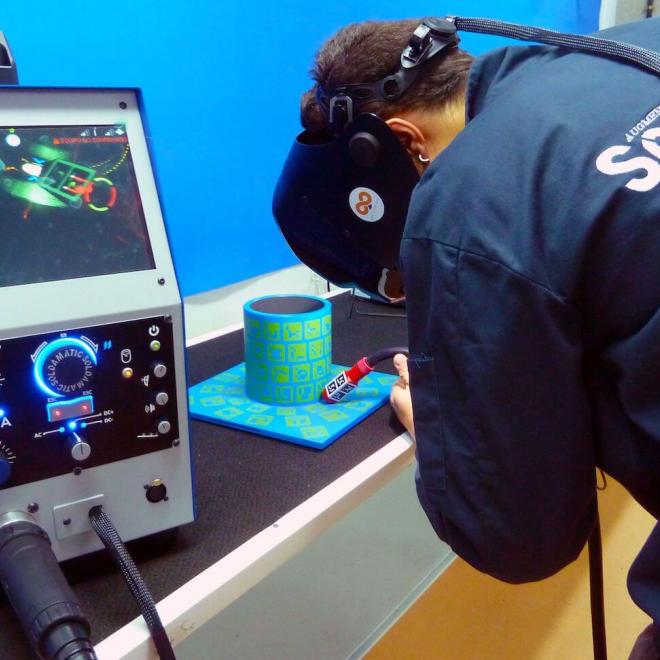Weld Australia is using advanced training technology to address a global shortage of skilled welders.
Despite a projected increase in demand, the welding workforce is shrinking.
Weld Australia estimates that by 2030, there will be 70,000 more welding vacancies across the country than people qualified to fill them. A situation likely to push up costs and delay delivery of Australia’s $155 billion rail investment pipeline.
To fill the gap, the nation’s peak industry body is improving and accelerating welding training using augmented reality technology.
By gamifying the process, it hopes to attract a new, more diverse generation of welders to the trade. Women are a special focus.
Weld Australia CEO Geoff Crittenden first spotted the Soldamatic simulator at an international conference six years ago. He was immediately fascinated by the new technology which has been specially designed to teach welding procedures and techniques in a safe, controlled environment.

The technology continually tests students’ angle, speed, heat and other factors while developing muscle memory.
As Australian’s first licensee, Weld Australia is introducing the technology to TAFEs, schools and prisons across the country.
“The feedback we’re getting has been overwhelmingly positive,” Geoff said.
“The move away from textbooks means students are much more engaged and keener to learn. They’re early to class and constantly challenging themselves to do better than their peers.”
For employers, the statistics are impressive.
“When using Soldamatics, 34 per cent more welders can be certified in 56 per cent less time, saving up to 68 per cent on the overall cost of welder training,” Geoff said.
“Whereas previously you could test up to three welding procedures a day at a cost of $2000 to $3000 each. Using the simulator, you can test up to 12 an hour at a fraction of the cost.”
As well as increasing the number of trained welders, Weld Australia is focused on raising skill levels and teaching standards.
It has created a set of training resources - including notes, lectures and assessments - certified to Australian and international ISO9606 standards.
These are being rolled out to TAFEs. Students who train through the system are assessed and accredited by Welding Australia. The qualifications are recognised nationally and overseas, opening the way for greater portability of workers.
“Ultimately, we want to get to the situation where someone in Kalgoorlie has the same access to training as people in Melbourne or Sydney.”
While the Soldamatic makes training easier, the trade remains hamstrung by the need for more teachers. As demand for skilled welders increases, the best trainers are regularly lured back to industry.
“We run a train-the-trainer course. But you have to be an experienced and competent welder before you can teach,” said Geoff, “Using simulators takes off some of the pressure but finding trainers is as rare as hen’s teeth.”
One way of increasing the talent pool is by diversifying to attract more women to the male-dominated trade.
The industry body has placed a focus on girls as part of its New South Wales Advanced Manufacturing School Outreach Program and has created a set of resources showing access and career pathways specifically targeted at women.
“Welding is no longer manual, dirty work. It is about precision and technique with lots of room for growth and promotion."
Find out more about Weld Australia’s certification and training programs.

How a local business group used a welding simulator to fill a dire need for welders across its membership

When a long-standing shortage of welders reached critical levels during the COVID pandemic, the South-East Melbourne Manufacturers Alliance (SEMMA) decided to take the problem in hand and develop their own welding training program.
Using a $200,000 grant from the Federal Department of Education, Skills and Employment, SEMMA launched a four-week welding course. The program equips participants with the basic skills needed to perform more than 70 per cent of welding tasks required by its members.
The unaccredited course is conducted by trainers from the Chisholm Institute, using modules from the institute's program adapted by SEMMA to manufacturers’ needs. The government grant covered the cost of trainers and the purchase of a Soldamatic virtual reality simulator from Weld Australia.
“The simulator was important for engaging young people and giving confidence to those who had never welded before,” said SEMMA CEO, Vonda Fenwick.
“It’s an important part of what could be seen as a ‘pre-apprenticeship’ program. It gives them experience quickly and safely and provides feedback to improve their performance.”

